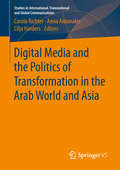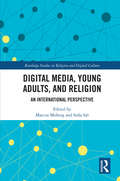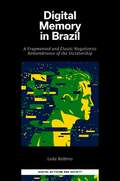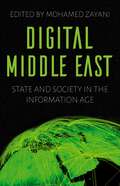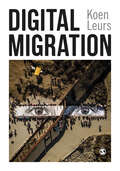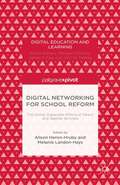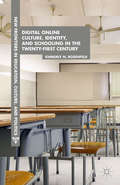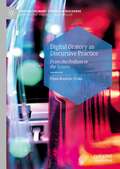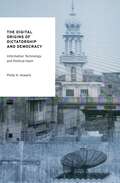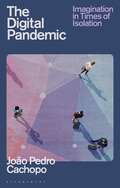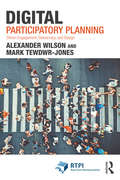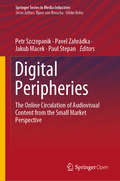- Table View
- List View
Digital Media and the Politics of Transformation in the Arab World and Asia (Studies in International, Transnational and Global Communications)
by Carola Richter Anna Antonakis Cilja HardersIn times of increasing mediatization and digitalization media play an important role in political and societal transformation processes. The authors of this volume take an actor-centered perspective to shed light on current cases in Arab and Asian countries. They inquire into the ways processes of networking and mobilization evolve in the context of restricted media systems and state-dominated public spheres. It features original research about various social and political actors such as women’s rights activists, public intellectuals, anarchists and Islamists.
Digital Media, Young Adults and Religion: An International Perspective (Routledge Studies in Religion and Digital Culture)
by Marcus Moberg Sofia SjöIt has become increasingly clear that an adequate understanding of the contemporary processes of social, cultural, and religious change is contingent on an appreciation of the growing impact of social media. Utilising results of an unprecedented global study, this volume explores the ways in which young adults in seven different countries engage with digital and social media in religiously significant ways. Presenting and analysing the findings of the global research project Young Adults and Religion in a Global Perspective (YARG), an international panel of contributors shed new light on the impact of social media and its associated technologies on young people’s religiosities, worldviews, and values. Case studies from China, Finland, Ghana, Israel, Peru, Poland, and Turkey are used to demonstrate how these developments are progressing, not just in the West, but across the world. This book is unique in that it presents a truly macroscopic perspective on trends in religion amongst young adults. As such, it will be of great interest to scholars working in religious studies, digital media, communication studies, sociology, cultural studies, theology and youth studies.
Digital Media, Young Adults and Religion: An International Perspective (Routledge Studies in Religion and Digital Culture)
by Marcus Moberg Sofia SjöIt has become increasingly clear that an adequate understanding of the contemporary processes of social, cultural, and religious change is contingent on an appreciation of the growing impact of social media. Utilising results of an unprecedented global study, this volume explores the ways in which young adults in seven different countries engage with digital and social media in religiously significant ways. Presenting and analysing the findings of the global research project Young Adults and Religion in a Global Perspective (YARG), an international panel of contributors shed new light on the impact of social media and its associated technologies on young people’s religiosities, worldviews, and values. Case studies from China, Finland, Ghana, Israel, Peru, Poland, and Turkey are used to demonstrate how these developments are progressing, not just in the West, but across the world. This book is unique in that it presents a truly macroscopic perspective on trends in religion amongst young adults. As such, it will be of great interest to scholars working in religious studies, digital media, communication studies, sociology, cultural studies, theology and youth studies.
Digital Memory in Brazil: A Fragmented and Elastic Negationist Remembrance of the Dictatorship (Digital Activism And Society: Politics, Economy And Culture In Network Communication)
by Leda BalbinoThe memory of the military dictatorship (1964-1985) in Brazil is still under dispute after almost 40 years of re-democratization. Narratives contradicting the memory critical to this regime started to spread digitally in the 2000s, with former army captain Jair Bolsonaro becoming one of its leading exponents. Digital Memory in Brazil draws on the results of three case studies to determine the strategies and practices applied by the Brazilian far-right government of Bolsonaro (2019-2023) to construct a negationist digital memory of the Brazilian dictatorship. Social media were crucial for Bolsonaro’s 2018 electoral campaign and government. Leda Balbino focuses on investigating this memory through its discursive processes and the impact of the digital medium on its development. Identifying a fragmented and elastic memory with the political purpose of promoting an authoritarian agenda under the vision of a Cultural War, Digital Memory in Brazil shows that the Bolsonaro government’s digital memory of the Brazilian Dictatorship was never just about the past. Instead, it represents a political project aiming to reverberate in the Brazilian present and future. Innovating by crisscrossing digital memory concept with studies on right-wing populism and digital populism, Digital Memory in Brazil exposes the strategies and practices of one of the exponents of a global political trend.
Digital Memory in Brazil: A Fragmented and Elastic Negationist Remembrance of the Dictatorship (Digital Activism And Society: Politics, Economy And Culture In Network Communication)
by Leda BalbinoThe memory of the military dictatorship (1964-1985) in Brazil is still under dispute after almost 40 years of re-democratization. Narratives contradicting the memory critical to this regime started to spread digitally in the 2000s, with former army captain Jair Bolsonaro becoming one of its leading exponents. Digital Memory in Brazil draws on the results of three case studies to determine the strategies and practices applied by the Brazilian far-right government of Bolsonaro (2019-2023) to construct a negationist digital memory of the Brazilian dictatorship. Social media were crucial for Bolsonaro’s 2018 electoral campaign and government. Leda Balbino focuses on investigating this memory through its discursive processes and the impact of the digital medium on its development. Identifying a fragmented and elastic memory with the political purpose of promoting an authoritarian agenda under the vision of a Cultural War, Digital Memory in Brazil shows that the Bolsonaro government’s digital memory of the Brazilian Dictatorship was never just about the past. Instead, it represents a political project aiming to reverberate in the Brazilian present and future. Innovating by crisscrossing digital memory concept with studies on right-wing populism and digital populism, Digital Memory in Brazil exposes the strategies and practices of one of the exponents of a global political trend.
Digital Middle East: State and Society in the Information Age
by Mohamed ZayaniIn recent years, the Middle East's information and communications landscape has changed dramatically. Increasingly, states, businesses, and citizens are capitalizing on the opportunities offered by new information technologies, the fast pace of digitization, and enhanced connectivity. These changes are far from turning Middle Eastern nations into network societies, but their impact is significant. The growing adoption of a wide variety of information technologies and new media platforms in everyday life has given rise to complex dynamics that beg for a better understanding. Digital Middle East sheds a critical light on continuing changes that are closely intertwined with the adoption of information and communication technologies in the region. Drawing on case studies from throughout the Middle East, the contributors explore how these digital transformations are playing out in the social, cultural, political, and economic spheres, exposing the various disjunctions and discordances that have marked the advent of the digital Middle East.
Digital Middle East: State and Society in the Information Age
In recent years, the Middle East's information and communications landscape has changed dramatically. Increasingly, states, businesses, and citizens are capitalizing on the opportunities offered by new information technologies, the fast pace of digitization, and enhanced connectivity. These changes are far from turning Middle Eastern nations into network societies, but their impact is significant. The growing adoption of a wide variety of information technologies and new media platforms in everyday life has given rise to complex dynamics that beg for a better understanding. Digital Middle East sheds a critical light on continuing changes that are closely intertwined with the adoption of information and communication technologies in the region. Drawing on case studies from throughout the Middle East, the contributors explore how these digital transformations are playing out in the social, cultural, political, and economic spheres, exposing the various disjunctions and discordances that have marked the advent of the digital Middle East.
Digital Migration
by Koen Leurs"A revelation for digital researchers and a provocation for migration scholars… It introduces an insightful, inspiring, and inviting way of making sense of the messiness without losing hope of changing things." - Nishant Shah, Chinese University of Hong Kong "A must read for everyone who is concerned with questions of human mobility, media and communications and the digital border." - Myria Georgiou, LSE "A much-needed addition to scholarship on mobility, technology, and migration… The book is poised to become a touchstone text." - C.L. Quinan University of Melbourne In contemporary discussions on migration, digital technology is often seen as a ′smart′ disruptive tool. Bringing efficiencies to management, and safety to migrants. But the reality is always more complex. This book is a comprehensive and impassioned account of the relationship between digital technology and migration. From ′top-down′ governmental and corporate shaping of the migrant condition, to the ′bottom-up′ of digital practices helping migrants connect, engage and resist. Taking an interdisciplinary approach, Digital Migration explores: The power relations of digital infrastructures across migrant recruitment, transportation and communication. Migrant connections and the use of digital devices, platforms and networks. Dominant digital representations of migrants, and how they’re resisted. The affect and emotion of digital migration, from digital intimacy to transnational family life. How histories of pre and early-digital migration help us situate and rethink contemporary research. The realities of researching digital migration, including interviews with leading international researchers. Critical yet hopeful, Koen Leurs opens up the unequal power relations at the heart of digital migration studies, challenging us to imagine more just alternatives. Koen Leurs is an Associate Professor in Gender, Media and Migration Studies at the Graduate Gender Program, Department of Media and Culture, Utrecht University, the Netherlands. All author royalties for this book will be donated to the Alarm Phone, a hotline for boatpeople in distress.
Digital Migration
by Koen Leurs"A revelation for digital researchers and a provocation for migration scholars… It introduces an insightful, inspiring, and inviting way of making sense of the messiness without losing hope of changing things." - Nishant Shah, Chinese University of Hong Kong "A must read for everyone who is concerned with questions of human mobility, media and communications and the digital border." - Myria Georgiou, LSE "A much-needed addition to scholarship on mobility, technology, and migration… The book is poised to become a touchstone text." - C.L. Quinan University of Melbourne In contemporary discussions on migration, digital technology is often seen as a ′smart′ disruptive tool. Bringing efficiencies to management, and safety to migrants. But the reality is always more complex. This book is a comprehensive and impassioned account of the relationship between digital technology and migration. From ′top-down′ governmental and corporate shaping of the migrant condition, to the ′bottom-up′ of digital practices helping migrants connect, engage and resist. Taking an interdisciplinary approach, Digital Migration explores: The power relations of digital infrastructures across migrant recruitment, transportation and communication. Migrant connections and the use of digital devices, platforms and networks. Dominant digital representations of migrants, and how they’re resisted. The affect and emotion of digital migration, from digital intimacy to transnational family life. How histories of pre and early-digital migration help us situate and rethink contemporary research. The realities of researching digital migration, including interviews with leading international researchers. Critical yet hopeful, Koen Leurs opens up the unequal power relations at the heart of digital migration studies, challenging us to imagine more just alternatives. Koen Leurs is an Associate Professor in Gender, Media and Migration Studies at the Graduate Gender Program, Department of Media and Culture, Utrecht University, the Netherlands. All author royalties for this book will be donated to the Alarm Phone, a hotline for boatpeople in distress.
Digital Migration
by Koen Leurs"A revelation for digital researchers and a provocation for migration scholars… It introduces an insightful, inspiring, and inviting way of making sense of the messiness without losing hope of changing things." - Nishant Shah, Chinese University of Hong Kong "A must read for everyone who is concerned with questions of human mobility, media and communications and the digital border." - Myria Georgiou, LSE "A much-needed addition to scholarship on mobility, technology, and migration… The book is poised to become a touchstone text." - C.L. Quinan University of Melbourne In contemporary discussions on migration, digital technology is often seen as a ′smart′ disruptive tool. Bringing efficiencies to management, and safety to migrants. But the reality is always more complex. This book is a comprehensive and impassioned account of the relationship between digital technology and migration. From ′top-down′ governmental and corporate shaping of the migrant condition, to the ′bottom-up′ of digital practices helping migrants connect, engage and resist. Taking an interdisciplinary approach, Digital Migration explores: The power relations of digital infrastructures across migrant recruitment, transportation and communication. Migrant connections and the use of digital devices, platforms and networks. Dominant digital representations of migrants, and how they’re resisted. The affect and emotion of digital migration, from digital intimacy to transnational family life. How histories of pre and early-digital migration help us situate and rethink contemporary research. The realities of researching digital migration, including interviews with leading international researchers. Critical yet hopeful, Koen Leurs opens up the unequal power relations at the heart of digital migration studies, challenging us to imagine more just alternatives. Koen Leurs is an Associate Professor in Gender, Media and Migration Studies at the Graduate Gender Program, Department of Media and Culture, Utrecht University, the Netherlands. All author royalties for this book will be donated to the Alarm Phone, a hotline for boatpeople in distress.
Digital Networking for School Reform: The Online Grassroots Efforts of Parent and Teacher Activists (Digital Education and Learning)
by Alison Heron-Hruby Melanie Landon-HaysPresenting school reform grassroots activists - teachers, parents, and organizers alike - in their own words, the editors document the newly emerged role of digital networks of activists in school reform and analyze their efforts as acts of critical literacy.
Digital Online Culture, Identity, and Schooling in the Twenty-First Century (New Frontiers in Education, Culture, and Politics)
by K. RosenfeldDigital Online Culture, Identity and Schooling in the Twenty-First Century provides a cultural, ideological critique of identity construction in the context of virtualization. Kimberly Rosenfeld explores the growing number of people who no longer reside in one physical reality but live, work, and play in multiple realities. Rosenfeld's critique of neo-liberal practices in the digital environment brings to light the on-going hegemonic and counter-hegemonic battles over control of education in the digital age. Rosenfeld draws conclusions for empowering the population through schooling, and how it should understand, respond to, and help individuals live out the information revolution.
Digital Oratory as Discursive Practice: From the Podium to the Screen (Postdisciplinary Studies in Discourse)
by Fiona Rossette-CrakeThis book offers an appraisal of oratory, old and new, relating former discourse practice to a specific sub-set of contemporary, digital practices. The author explores the interface between language and society, providing an interdisciplinary study at the crossroads of discourse, linguistics, communication and rhetoric. The comparisons she draws are particularly pertinent in light of the steep rise in presentations given during video-conferences, webinars, and other online events during the COVID-19 pandemic, an event which accelerated previous moves towards digital communication and which is likely to have a long-term impact on communication styles. This book will be of interest to academics and students in fields including discourse analysis, applied linguistics, communication studies, digital studies and business studies.
The Digital Origins of Dictatorship and Democracy: Information Technology and Political Islam (Oxford Studies in Digital Politics)
by Philip N. HowardAround the developing world, political leaders face a dilemma: the very information and communication technologies that boost economic fortunes also undermine power structures. Globally, one in ten internet users is a Muslim living in a populous Muslim community. In these countries, young people are developing political identities online, and digital technologies are helping civil society build systems of political communication independent of the state and beyond easy manipulation by cultural or religious elites. With unique data on patterns of media ownership and technology use, The Digital Origins of Dictatorship and Democracy demonstrates how, since the mid-1990s, information technologies have had a role in political transformation. Democratic revolutions are not caused by new information technologies. But in the Muslim world, democratization is no longer possible without them.
The Digital Origins of Dictatorship and Democracy: Information Technology and Political Islam (Oxford Studies in Digital Politics)
by Philip N. HowardAround the developing world, political leaders face a dilemma: the very information and communication technologies that boost economic fortunes also undermine power structures. Globally, one in ten internet users is a Muslim living in a populous Muslim community. In these countries, young people are developing political identities online, and digital technologies are helping civil society build systems of political communication independent of the state and beyond easy manipulation by cultural or religious elites. With unique data on patterns of media ownership and technology use, The Digital Origins of Dictatorship and Democracy demonstrates how, since the mid-1990s, information technologies have had a role in political transformation. Democratic revolutions are not caused by new information technologies. But in the Muslim world, democratization is no longer possible without them.
The Digital Pandemic: Imagination in Times of Isolation
by João Pedro CachopoA refreshing approach to the dominance of technology in our contemporary lives, The Digital Pandemic, translated from Portuguese, poses fundamental questions about love, fear, connectedness, proximity, imagination and consciousness.Arguing that the pandemic has ushered in a civilizational digital shock, João Pedro Cachopo charts new channels of relatedness and communication between people through digital technologies for the foreseeable future. The transformation of human experience that began in 2020 creates a break in our sociality that Cachopo pinpoints through key themes of love, travel, study, community and art.In contrast to the growing philosophical literature on the pandemic, this bold theoretical work does not prophesy the fall of capitalism or the end of personal freedom and relationships. Instead, this book carefully investigates the advanced technology that is increasingly inextricable from our lives, using an alternative approach that avoids pessimism, while remaining alert to the risks and threats of the digital age. It opens up the possibility of fostering global solidarity and consciousness beyond physical borders in the 21st century.
The Digital Pandemic: Imagination in Times of Isolation
by João Pedro CachopoA refreshing approach to the dominance of technology in our contemporary lives, The Digital Pandemic, translated from Portuguese, poses fundamental questions about love, fear, connectedness, proximity, imagination and consciousness.Arguing that the pandemic has ushered in a civilizational digital shock, João Pedro Cachopo charts new channels of relatedness and communication between people through digital technologies for the foreseeable future. The transformation of human experience that began in 2020 creates a break in our sociality that Cachopo pinpoints through key themes of love, travel, study, community and art.In contrast to the growing philosophical literature on the pandemic, this bold theoretical work does not prophesy the fall of capitalism or the end of personal freedom and relationships. Instead, this book carefully investigates the advanced technology that is increasingly inextricable from our lives, using an alternative approach that avoids pessimism, while remaining alert to the risks and threats of the digital age. It opens up the possibility of fostering global solidarity and consciousness beyond physical borders in the 21st century.
Digital Participatory Planning: Citizen Engagement, Democracy, and Design (RTPI Library Series)
by Alexander Wilson Mark Tewdwr-JonesDigital Participatory Planning outlines developments in the field of digital planning and designs and trials a range of technologies, from the use of apps and digital gaming through to social media, to examine how accessible and effective these new methods are. It critically discusses urban planning, democracy, and computing technology literature, and sets out case studies on design and deployment. It assesses whether digital technology offers an opportunity for the public to engage with urban change, to enhance public understanding and the quality of citizen participation, and to improve the proactive possibilities of urban planning more generally. The authors present an exciting alternative story of citizen engagement in urban planning through the reimagination of participation that will be of interest to students, researchers, and professionals engaged with a digital future for people and planning.
Digital Participatory Planning: Citizen Engagement, Democracy, and Design (RTPI Library Series)
by Alexander Wilson Mark Tewdwr-JonesDigital Participatory Planning outlines developments in the field of digital planning and designs and trials a range of technologies, from the use of apps and digital gaming through to social media, to examine how accessible and effective these new methods are. It critically discusses urban planning, democracy, and computing technology literature, and sets out case studies on design and deployment. It assesses whether digital technology offers an opportunity for the public to engage with urban change, to enhance public understanding and the quality of citizen participation, and to improve the proactive possibilities of urban planning more generally. The authors present an exciting alternative story of citizen engagement in urban planning through the reimagination of participation that will be of interest to students, researchers, and professionals engaged with a digital future for people and planning.
Digital Parties: The Challenges of Online Organisation and Participation (Studies in Digital Politics and Governance)
by Oscar Barberà Giulia Sandri Patricia Correa Juan Rodríguez-TeruelThis book analyzes how mainstream and new parties are building their digital platforms and transitioning from traditional (offline) organizations into the digital world.The authors present an innovative empirical exploration of the democratic consequences and technical challenges of the digitalization of party organizations from a comparative perspective. They provide an original account of how party digital platforms are regulated and used, and a crucial discussion of the main technological and democratic issues that political parties face in their digital transition. Further, the authors assess the consequences of these digitalization processes for political participation and party membership, as well as the impact on party organizational models and electoral campaign potential. The book looks into one of the less-studied aspects of digital democracy, also presenting empirical evidence and case studies. It presents different parties and their adoption of digital participation platforms, from the Pirate Parties in Northern Europe to Podemos in Spain, La France Insoumise in France, the Five Stars Movement in Italy, or the German Greens.Therefore, the book is a must-read for scholars of political science, policy-makers, and practitioners, interested in a better understanding of the transition of political parties into the digital world.
Digital Peripheries: The Online Circulation of Audiovisual Content from the Small Market Perspective (Springer Series in Media Industries)
by Petr Szczepanik Pavel Zahrádka Jakub Macek Paul StepanThis is an open access book. Media industry research and EU policymaking are predominantly tailored to large (and, in the latter case, Western) European markets. This open access book addresses the specific qualities of smaller media markets, highlighting their vulnerability to global digital competition and outlining survival strategies for them. New online distribution models and new trends in the consumption of audiovisual content are limited by, and pose new challenges for, existing audiovisual business models and their legal framework in the EU. The European Commission’s Digital Single Market (DSM) strategy, which was intended e.g. to remove obstacles to the cross-border distribution of audiovisual content, has triggered a heated debate on the transformation of the existing ecosystem for European screen industries. While most current discussions focus on the United States, Western Europe, and the multinational giants, this book approaches these industry trends and policy questions from the perspective of relatively small and peripheral (in terms of their population, language, cross-border cultural flows, and financial and/or symbolic capital) media markets.
Digital Photogrammetry: A Practical Course
by Wilfried LinderThe fourth edition is again an "all-in-one" combination of basic theory and practical exercises with software and data available from the Springer server. Potential readers / users are students of Photogrammetry, Geodesy, Geography and other sciences, but also all who are interested in this topic. No prior knowledge is necessary, except the handling of standard PCs. Theory is presented true to the motto "as little as possible, but as much as necessary". The main part of the book contains several tutorials. In increasing complexity, accompanied by texts explaining further theory, the reader can proceed step by step through the particular working parts. All intermediate as well as the final results are discussed with reference to accuracy and error handling, and included in the data sets to provide controls. Most of the standard work in Digital Photogrammetry is shown and trained, for example scanning, image orientation, stereo plotting, aerial triangulation measurement (manual and automatic), block adjustment, automatic creation of surface models via image matching, creation of ortho images and mosaics, and others. Examples of both aerial and close-range photogrammetry present the power of this kind of measurement techniques. 3-D images can be viewed with the accompanying 3-D glasses. During the time since the last edition, the software development went on, and therefore it was necessary to adopt the text to the actual program versions which were also tested to work properly under MS Windows 10. Few options which are obsolete nowadays were removed, some new options were added, the handling of the software was simplified in several places, and so on. For the use of own images taken with a custom digital camera, a new chapter offers an easy way of lens calibration and explains how to get good results with a minimum of work. The software is not limited to the example data included but may be used for personal projects. Part of the book comprises a complete description of the software.
Digital Photogrammetry: A Practical Course
by Wilfried Linder1.1 Basic idea and main task of photogrammetry If you want to measure the size of an object, let’s say the length, width and height of a house, then normally you will carry this out directly at the object. Now imagine that the house didn’t exist anymore – it was destroyed, but some historic photos exist. Then, if you can determine the scale of the photos, it must be pos- ble to get the desired data. Of course you can use photos to get information about objects. This kind of - formation is different: So, for example, you may receive qualitative data (the house seems to be old, the walls are coloured light yellow) from photo interpre- tion, or quantitative data like mentioned before (the house has a base size of 8 by 6 meters) from photo measurement, or information in addition to your background knowledge (the house has elements of the “art nouveau” style, so may be c- th structed at the beginning of the 20 century), and so on.
Digital Photogrammetry: Theory and Applications
by Wilfried LinderPhotogrammetry is a science based technology with more than a century of history and development. During this time, the techniques used to get information about objects represented in photos have changed dramatically from pure optic mechanical equipment to a fully digital workflow in our days. Parallel to this, the handling became easier, and so its possible also for non-photogrammetrists to use these methods today. This book is especially written for potential users which have no photogram metric education but would like to use the powerful capabilities from time to time or in smaller projects: Geographers, Geologists, Cartographers, Forest Engineers who would like to come into the fascinating field of photogrammetry via "learning by doing". For this reason, this book is not a textbook - for more and deeper the ory, there exists a lot ofliterature, and it is suggested to use some ofthis. A special recommendation should be given to the newest book from KONECNY (2002) for basic theory and the mathematical backgrounds or to the book from SCHENK (1999) for the particular situation in digital photogrammetry. For a quick reference especially to algorithms and technical terms see also the Photogrammetric Guide from ALBERTZ & KREILING (1989). This book includes a CD-ROM which contains all you need from software and data to learn about the various methods from the beginning (scanning of the pho tos) to final products like ortho images or mosaics.
Digital Photogrammetry: A Practical Course
by Wilfried LinderPotential readers/users are students of Photogrammetry, Geodesy, Geography and other sciences, but also all who are interested in this topic. No prior knowledge is necessary, except the handling of standard PCs. Theory is presented true to the motto "as little as possible, but as much as necessary".The main part of the book contains several tutorials. In increasing complexity, accompanied by texts explaining further theory, the reader can proceed step by step through the particular working parts. Most of the standard work in Digital Photogrammetry is shown and trained for example scanning, image orientation, mono and stereo plotting, aerial triangulation measurement (manual and automatic), block adjustment, automatic creation of surface models via image matching, creation of ortho images and mosaics, and others. Not only standard situations are dealt with but also more complex ones, such as unknown camera data, extreme relief or areas with very low contrast. Examples of both aerial and close-range photogrammetry present the power of these type of measurement techniques.The software is not limited to the example data included but may be used for personal projects. Part of the book comprises a complete description of the software.
